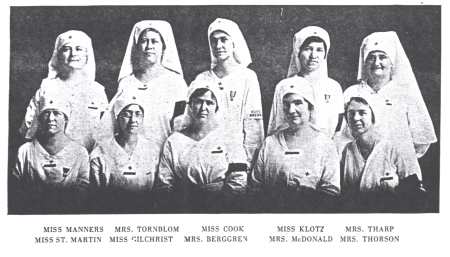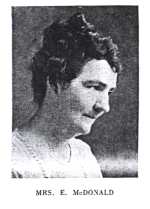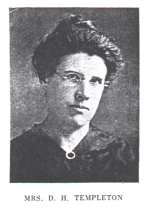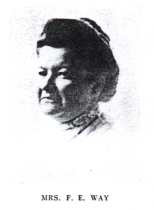Surgical Dressing Department

Miss Caroline Cook was appointed chairman of the surgical dressing department in August, 1917. Surgical dressings were made under the direction of supervisors who had taken the course in making surgical dressings.
The work of building up this department was very difficult because it had been rumored about that surgical dressings were very hard to make. All workers in the department were required to wear large white cover-all aprons and white coifs. The progress of the department was slow, but as the people realized the necessity of a large output of surgical dressings and the ease with which they were made, classes increased in number thruout the county.
The preparing of materials for the classes was a great problem. It was difficult to prepare work for them all even with the help of several others. At first all material was cut by drawing threads, and all instructors had to see that their individual classes were supplied with work. To meet this situation a cutting machine was supplied in February, 1918, and the chairman superintended the cutting of all material for branches. Every dressing made by the branches was censored by the chairman and her assistants. It was her thoroness in instructing and censoring that won praise for the department from the state censor, Mrs. Baldridge.
The success of this department was not due to any individual or organization, but to the wonderful co-operation of Miss Cook, her corps of supervisors, and every individual worker.
All quotas were filled on time, the only trouble was that the quota for Saunders County was entirely too small.
Miss Cook and Miss Klotz practically handled every dressing made by the chapter. They packed them all, often working until late at night, for hours were never too long nor work too hard for them. 169,142 dressings were censored, tied, packed, and sent to the warehouse, besides thousands of cut dressings which were on hand at the close of the armistice.

First Aid

The first class in first aid in Saunders County was organized in the Wahoo branch in the summer of 1917. Twenty-seven members took instruction under Dr. F. E. Way. Twenty-four took the examination under J. F. Lauvetz and received the Red Cross First Aid Certificates.
In January Mrs. E. McDonald was appointed chairman of the First Aid Committee and organized classes as follows:
Swedeburg, 22 members, Dr. J. F. Lauvetz, instructor; Ceresco, 38 members, Dr. F. F. Wright, instructor.
The Home Economics organization placed first aid books as follows: Individuals' and mothers' club, Wahoo, 27; Ithaca, 12; Mead, 18; Weston, 11; Morse Bluff, 16; Prague, 16; Leshara, 7; Wann, 11; Yutan, 9; Malmo, 9.
Nursing Survey
At the request of the secretary of war and the surgeon general of the army, the nation was requested to make a nation-wide survey of the nursing resources. On January 1, 1917, Mrs. McDonald was appointed to take charge of the work.
Hospital Garments

With the reorganization of the bureau of supplies in June, 1918, Mrs. I. R. Edwards was put in charge of the hospital garments. Mrs. Edwards was quite familiar with this kind of work, having had charge one day a week of the workroom of the Wahoo Branch. Because of this work she was well qualified to take over the county work. The start had been made in this work by Mrs. M. A. Miller, but it was no easy task to keep things running smoothly. The department looked after all finished work. All garments made by the separate branches had to be inspected, folded, tied in packages of five and ten, and packed.
The quotas were given Mrs. Edwards, who pro-rated them to all branches, turning same over to supply chairman, who in turn sent materials to the various branches for filling these quotas.
The success of the department is due to the untiring efforts of the ladies in charge and their assistants. The department has 11,788 garments to its credit.
Comfort Kits
Almost the first sewing undertaken by the chapter was the making of comfort kits. The chapter furnished the material and the friends and relatives of the boys leaving were asked to fill the kits after they were made up by the ladies of the various branches and auxiliaries of the county. Every boy going from the county was supplied with a well filled kit until orders were received from the central division to discontinue furnishing kits, as the men received most of the articles after reaching camp.
Cutting kits proved very hard work on account of the heavy material used. Mrs. John Thorson deserves special mention in this connection, having cut almost all the kits made in the entire chapter.
Quotas for the several hundred kits to be made were then returned to be distributed thru the camps. This department was looked after by the chapter secretary, Miss Lottie Klotz, until May 1, 1918, when Mrs. D. H. Templeton was appointed chairman. Every branch and auxiliary in the chapter assisted in making and filling kits.
Knitting Department


The chapter received the first request for work in August, 1917, by J. J. O'Connor, director of the Central Division. He gave a quota on knitting for Saunders County. It was asked to furnish 60 of each of the following: Sweaters, mufflers, pairs of sox, pairs of wristlets.
This necessitated the organization of the knitting department, and a more capable woman than Mrs. T. J. Pickett could not have been found, who had long been known for her ability to execute all known knitting stitches.
The organization of this department was no easy task, for comparatively few knew the meaning of "knit 2, purl 2." Mrs. Pickett not only was county chairman but acted as instructor as well, and a great many Saunders County women owe their knowledge of the art of knitting to Mrs. Pickett.
Under her able management it was not long before every one was busy knitting, and they literally "ate" the work, they accomplished so much. As the chapter increased in size, the work of inspecting the finished articles became quite a task, because of errors in them, and finally an assistant chairman was appointed. So in November, 1917, Mrs. Dr. F. E. Way was appointed to assist Mrs Pickett in the unraveling and untangling the "knit 2, purl 2" of the department. These ladies were censors for all work turned in, and they preferred to remodel the wrong ones instead of sending them to headquarters and having it done there. By so doing they won a reputation for Saunders County at the State Warehouse at Omaha. The knitting department had many loyal workers and made a wonderful reputation of which we may all be proud.
From August 1917, to August, 1919, they shipped 6,380 garments.
| 








